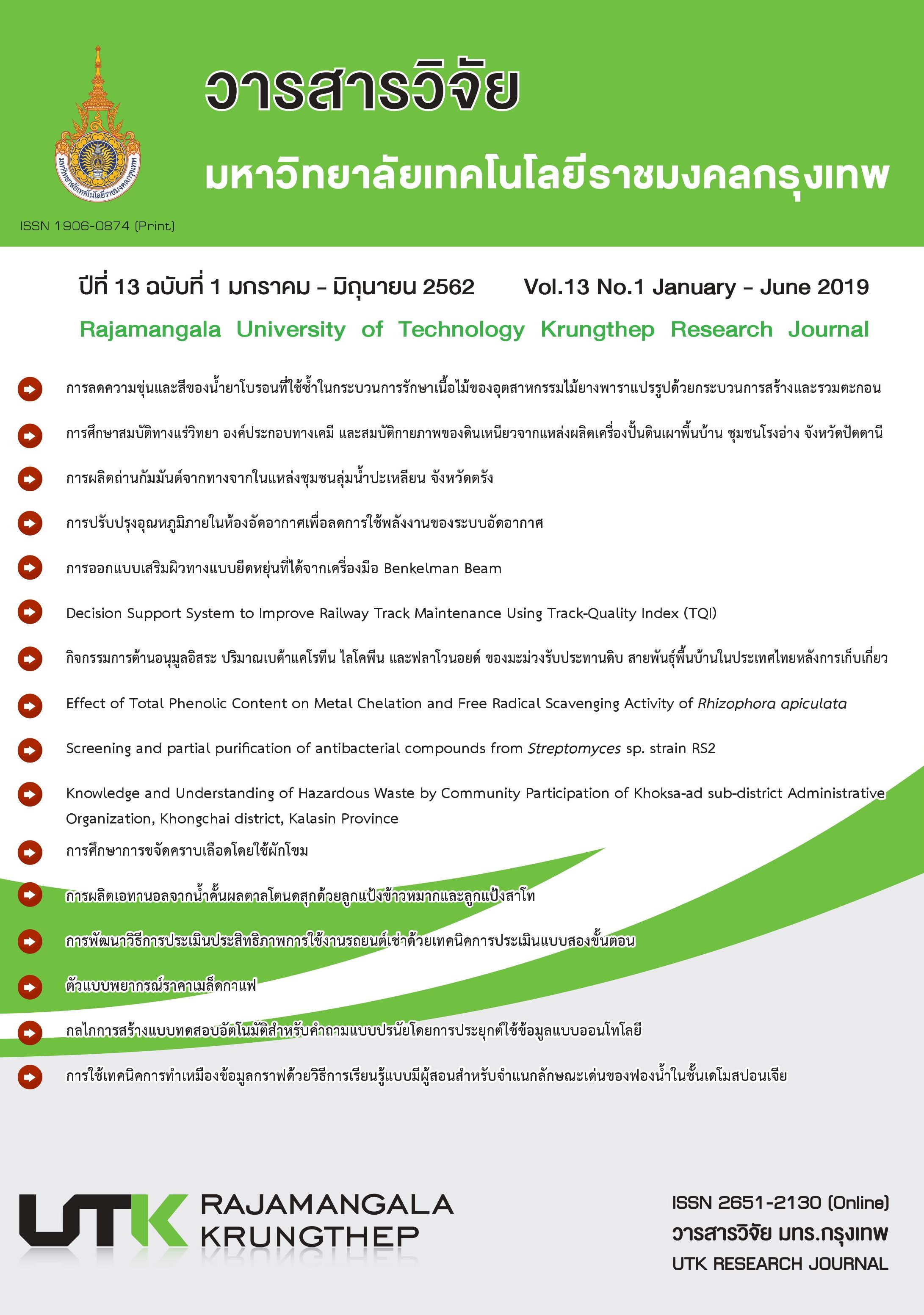การผลิตเอทานอลจากน้ำคั้นผลตาลโตนดสุกด้วยลูกแป้งข้าวหมากและลูกแป้งสาโท
Main Article Content
บทคัดย่อ
ผลตาลโตนดสุกเป็นวัสดุเหลือทิ้งทางการเกษตรที่สามารถนำมาใช้ผลิตพลังงานทดแทน น้ำคั้นของเนื้อผลตาลสุกมีองค์ประกอบที่สำคัญ คือ คาร์โบไฮเดรต 108.01 ± 0.05 g/L และน้ำตาล 64.36 ± 1.67 g/L สามารถนำมาใช้เป็นวัตถุดิบในการหมักเอทานอล งานวิจัยนี้ศึกษาการผลิตเอทานอลจากน้ำคั้นของเนื้อผลตาลสุกโดยใช้ลูกแป้งข้าวหมากและลูกแป้งสาโท ทำการศึกษาผลของความเข้มข้นของน้ำตาลรีดิวซ์ในน้ำคั้นผลตาลโตนดสุกโดยใช้ปริมาณของน้ำคั้นที่ 20, 40, 60, 80, และ 100% v/v พบว่าที่ปริมาณของน้ำคั้น 100% v/v จะให้ปริมาณของเอทานอลสูงที่สุดสำหรับการหมักด้วยลูกแป้งทั้งสองชนิด ทำการศึกษาผลของพีเอชที่มีต่อประสิทธิภาพการหมักเอทานอลที่พีเอช 4.5, 4.8, 5.0 และ 5.5 พบว่าพีเอชที่เหมาะสมของการหมักด้วยลูกแป้งข้าวหมากและลูกแป้งสาโท คือ พีเอช 4.5 และ พีเอช 5.0 ตามลำดับ การหมักเอทานอลโดยใช้ลูกแป้งข้าวหมากที่สภาวะที่เหมาะสมให้ปริมาณของเอทานอลสูงสุด 10.57 ± 0.03 g/L ที่เวลาในการหมัก 48 h ให้ผลได้ 0.23 ± 0.001 g/g อัตราการผลิตเอทานอล 0.22 ± 0.001 g/L/h และประสิทธิภาพของการหมัก 45.08 ± 0.15 % สำหรับการหมักด้วยลูกแป้งสาโท พบว่าให้ปริมาณของเอทานอลสูงสุด 7.93 ± 0.03 g/L ที่เวลาในการหมัก 48 h มีผลได้ อัตราการผลิตเอทานอล และประสิทธิภาพของการหมักเท่ากับ 0.17 ± 0.001 g/g, 0.17 ± 0.001 g/L/h และ 32.7 ± 0.02% ตามลำดับ ซึ่งต่ำกว่าการหมักโดยใช้ลูกแป้งข้าวหมากอย่างมีนัยสำคัญทางสถิติที่ระดับความเชื่อมั่น 95%
Article Details
กองบรรณาธิการวารสารวิชาการ มหาวิทยาลัยเทคโนโลยีราชมงคลกรุงเทพ มีความยินดีที่จะรับบทความจากอาจารย์ นักวิจัย นักวิชาการทั้งภายในและภายนอกมหาวิทยาลัย ในสาขาวิชาวิทยาศาสตร์และเทคโนโลยี ได้แก่ สาขาวิชาวิทยาศาสตร์ วิศวกรรมศาสตร์ และสาขาอื่นๆ ที่เกี่ยวข้อง รวมถึงสาขาต่างๆ ที่มีการบูรณาการข้ามศาสตร์ที่เกี่ยวข้องวิทยาศาสตร์และเทคโนโลยี ที่เขียนเป็นภาษาไทยหรือภาษาอังกฤษ ซึ่งผลงานวิชาการที่ส่งมาขอตีพิมพ์ต้องไม่เคยเผยแพร่ในสิ่งพิมพ์อื่นใดมาก่อน และต้องไม่อยู่ในระหว่างการพิจารณาของวารสารอื่น
การละเมิดลิขสิทธิ์ถือเป็นความรับผิดชอบของผู้ส่งบทความโดยตรง บทความที่ได้รับการตีพิมพ์ต้องผ่านการพิจารณากลั่นกรองคุณภาพจากผู้ทรงคุณวุฒิและได้รับความเห็นชอบจากกองบรรณาธิการ
ข้อความที่ปรากฏอยู่ในแต่ละบทความที่ตีพิมพ์ในวารสารวิชาการเล่มนี้ เป็นความคิดเห็นส่วนตัวของผู้เขียนแต่ละท่าน ไม่เกี่ยวข้องกับมหาวิทยาลัยเทคโนโลยีราชมงคลกรุงเทพแต่อย่างใด ความรับผิดชอบด้านเนื้อหาและการตรวจร่างบทความแต่ละบทความเป็นของผู้เขียนแต่ละท่าน หากมีความผิดพลาดใดๆ ผู้เขียนแต่ละท่านจะต้องรับผิดชอบบทความของตนเองแต่ผู้เดียว
กองบรรณาธิการขอสงวนสิทธิ์มิให้นำเนื้อหา หรือข้อคิดเห็นใดๆ ของบทความในวารสารวิชาการ มหาวิทยาลัยเทคโนโลยีราชมงคลกรุงเทพ ไปเผยแพร่ก่อนได้รับอนุญาตจากกองบรรณาธิการ อย่างเป็นลายลักษณ์อักษร ผลงานที่ได้รับการตีพิมพ์ถือเป็นลิขสิทธิ์ของวารสาร
References
[2] Derman E, Abdulla R, Marbawi H, et al. Oil palm empty fruit bunches as a promising feedstock for bioethanol production in Malaysia. Renew Energ. 2018; 129:285-298.
[3] Azhar HSM, Abdulla R, Jambo SA, et al. Yeasts in sustainable bioethanol production: A review. Biochem Biophys Reports. 2017; 10:52–61.
[4] Jiang D, Hao M, Fu J, et al. Potential bioethanol production from sweet sorghum on marginal land in China. J Clean Prod. 2019; 220:225-234.
[5] Demirbas A. Biofuels securing the planet’s future energy needs. Energy Convers Manag. 2009; 50(9):2239–2249.
[6] Nieves DC, Alanís MJR, Quiroz RC, et al. Current status and future trends of bioethanol production from agro-industrial wastes in Mexico. Renew Sust Energ Rev. 2019; 102:63-74.
[7] Roble ND, Ogbonna JC, Tanaka H. A novel circulating loop bioreactor with cells immobilized in loofa (Luffa cylindrica) sponge for the bioconversion of raw cassava starch to ethanol. Appl Microbiol Biotechnol. 2003; 60(6):671–678.
[8] Artnarong S, Masniyom P, Maneesri J. Preparation of the substrate from Palmyra palm fruit by Candida stellimalicola fermentation for acetic acid production. KKU Res J. 2016; 21(2):697-403.
[9] Theivendirarajah K, Chrystopher RK, Alcohol from palmyra palm (Borassus Flabellifer L.) fruit pulp. Vinganam J Sci. 1986; 1:44-46.
[10] Kassim MA, Kheang LS, Bakar NA, et al. Biothanol production from enzymatically saccharified empty fruit bunches hydrolysate using Saccharomyces cerevisiae. Res J Environ Sci. 2011; 5(6):573–586.
[11] Teeparuksapun K, Sontimuang C, Congkumnert W. Comparative study of hydrolysis methods for bioethanol production from ripe palmyra palm fruit pulp (Borassus flabellifer Linn). using Saccharomyces cerevisiae TISTR5204. The 7th International Conference on Fermentation Technology for Value Added Agriculture Products; 2017 July 25-28; Khon Kaen, Thailand. Khon Kaen University; 2017. P. 256-264.
[12] Chongkhong S, Mardla A, Yai H. Ensiling -wet-storage method for bio-ethanol production by baker ’ s yeast. The 10th International PSU Engineering Conference; 2012 May 14-15; Hat Yai, Thailand. Prince of Songkla University. 2012. P. 8–11.
[13] Pfeiffer T, Morley A, An evolutionary perspective on the Crabtree effect. Front Mol Biosci. 2014; 1:1-6.
[14] Deesuth O, Samneing A, Laopaiboon P, et al. Decrease in ethanol fermentation time for Sato making by Rhizopus sp And mixed cultures of yeasts. KKU Res J. 2010; 15(7):670–678.
[15] Sridam P, Dajanta K. Screening of potential indigeneous Loog Pang for production of fermented glutinous rice (KhaoMak) with high total soluble solid and lower alcohol ordor. The 15th National and International Conference Interdisciplinary Research for Local Development Sustainability; Lampang, Thailand. Lampang Rajabhat University. 2015; 129-139.
[16] Morris DL. Quantitative determination of carbohydrates with dreywood’s anthrone reagent. Science. 1948; 107(1):254-255.
[17] Miller GL. Use of Dinitrosalicylic acid regent for determination of reducing sugar. Anal Chem. 1959; 31:426-428.
[18] Reed G, Nagodawithana TW. Baker’s yeast production. Yeast Technol. New York: Springer, Dordrecht; 1991. P. 261-314.

